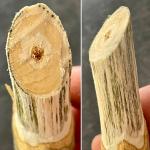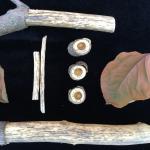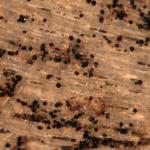Verticillium Wilt
Pathogens
Verticillium wilt is caused by Verticillium dahliae and V. albo-atrum. However, V. dahliae is believed to responsible for the majority of infections on woody plants in North America (Sinclair and Lyon 2005).
Hosts
Various trees and shrubs are susceptible to Verticillium wilt in the region. The most common hosts in landscape settings include: maple (Acer), elm (Ulmus), smoketree (Cotinus), ash (Fraxinus), tulip poplar (Liriodendron), Viburnum, redbud (Cercis), Catalpa, Magnolia, Kentucky coffee tree (Gymnocladus dioicus) and Russian olive (Elaeagnus angustifolia). In southern New England, native and non-native maples are the most frequent host for the pathogen. In many cases, these trees are weakened by other landscape stresses, facilitating disease development.
Symptoms & Spread
Verticillium wilt is a damaging vascular disease for an array of woody ornamentals and can be pervasive once it establishes at a site. Infections from Verticillium originate in the soil, when the fungus invades the root system of susceptible trees and shrubs. Once the fungus becomes established in the vascular system, it is transported into and throughout the canopy. Verticillium also grows through ray cells to penetrate deep into the secondary xylem. The most commonly observed symptoms include marginal leaf scorch, leaf wilting, vascular staining and branch dieback. Because there is a disruption of water and mineral transport to the affected branches and leaves, the symptoms appear similar to those caused by root and cankering diseases, drought, and mechanical root damage (e.g. severing, crushing or compaction). Therefore, careful examination is required to rule out these other possible stresses. Acute foliar symptoms can develop quickly after infection and range from wilting, desiccation, marginal/interveinal browning and premature shedding of the foliage on a single branch or a particular area of the tree’s canopy. These symptoms can appear at any time during the growing season, but most often develop during hot and dry periods. More frequently, woody plants develop chronic symptoms that resemble a tree in decline, such as stunted growth, marginal leaf scorch, undersized and sparse foliage, heavy seed production and scattered branch dieback. The vascular staining that results from the disease is the best diagnostic symptom for identification of Verticillium wilt and to determine if additional testing to confirm the pathogen is necessary. However, keep in mind that staining is not always present on infected trees and shrubs. Vascular staining is often olive-green in color but may range from yellow to brown, depending on the host. Because of the pathogen’s ability to move through ray cells, staining may be present deep in the xylem tissue and not in the outer vascular tissue just under the bark (where vascular staining caused by Dutch elm disease is often observed).
One of the most interesting features of Verticillium is its ability to produce microsclerotia. These are microscopic, black-colored resting structures that resemble a small seed. Once Verticillium has caused disease, microsclerotia are produced within a variety of dead plant parts, including roots, stems and leaves. They allow the pathogen to overwinter in dead plant tissues and when produced in the soil, allow the fungus to persist for many years at the site. When infected leaves and stems fall to the ground, the fungus can also grow into the soil to overwinter. Contact between neighboring, healthy roots and dead, diseased roots can allow Verticillium to spread locally. Overland spread can occur when infected leaves are dispersed away from an infected tree by wind. In addition, Verticillium can infect several resistant weedy plants and create new microsclerotia without ever causing any above-ground symptoms. Therefore, once the fungus is established at a site it can remain there indefinitely.
Management
Verticillium is widespread in forest and landscape settings, yet disease incidence remains relatively low in most cases, signifying that many plants are able to resist the pathogen when attacked. The impact of Verticillium wilt depends on the inherent susceptibility of a particular tree or shrub, environmental stress that may be present (especially drought and root damage), and the virulence of the pathogen. Maintaining high tree vigor is essential, since the tree’s natural defense response may be able to compartmentalize the infection. For recently transplanted trees and shrubs, provide regular irrigation during extended dry periods, fertilize as needed and maintain an adequate mulch layer over as much of the root zone as possible. These activities do not have direct impacts on the pathogen itself, but they serve to enhance the tree's ability to resist infections. Reduce inoculum and improve the appearance of infected trees and shrubs by removing dead shoots and branches. Keep in mind, however, that pruning does not eliminate Verticillium from the plant since infections first establish from the roots. At times, however, infected plants may experience a partial canopy dieback but survive and over time, can once again flourish with proper care. Because of the soilborne nature of the fungus and its establishment within the roots, fungicides often have little to no effect. Use of resistant or immune trees and shrubs as replacement for those infected with Verticillium wilt is often the only viable strategy in landscape settings. A selected list of resistant trees and shrubs include: apple/crabapple (Malus), beech (Fagus), birch (Betula), boxwood (Buxus), dogwood (Cornus), hackberry (Celtis), hawthorn (Crataegus), hickory (Carya), holly (Ilex), honeylocust (Gleditsia triacanthos), katsura (Cercidiphyllum), linden (Tilia), mountain-ash (Sorbus), oak (Quercus), pear (Pyrus), aspen/poplar (Populus), sycamore/planetree (Platanus), sweetgum (Liquidambar) and walnut (Juglans). All conifers are also resistant or immune to Verticillium wilt. Resistance does not imply immunity; therefore some of the plants listed here may be susceptible to infection. For a more exhaustive list of resistant and immune woody plants, see page 242 in Sincliar and Lyon (2005).
For more information, see: Sinclair, W.A. and H.H. Lyon. 2005. Diseases of Trees and Shrubs, 2nd edn. Cornell University Press, Ithaca, NY.





